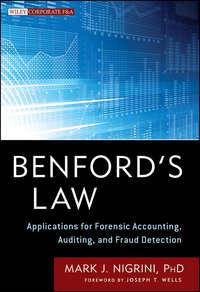Benford′s Law. Applications for Forensic Accounting, Auditing, and Fraud Detection

Mark Nigrini и Joseph Wells
Язык книги:Английский
Тип:PDF книга
Издательство:John Wiley & Sons Limited
Дата публикации:09.12.2022
Стоимость: 7731.03 ₽
Просмотры:109
Отзывы:Пока нет Добавить отзыв
О книге: A powerful new tool for all forensic accountants, or anyone who analyzes data that may have been altered Benfords Law gives the expected patterns of the digits in the numbers in tabulated data such as town and city populations or Madoffs fictitious portfolio returns. Those digits, in unaltered data, will not occur in equal proportions; there is a large bias towards the lower digits, so much so that nearly one-half of all numbers are expected to start with the digits 1 or 2. These patterns were originally discovered by physicist Frank Benford in the early 1930s, and have since been found to apply to all tabulated data. Mark J. Nigrini has been a pioneer in applying Benfords Law to auditing and forensic accounting, even before his groundbreaking 1999 Journal of Accountancy article introducing this useful tool to the accounting world. In Benfords Law, Nigrini shows the widespread applicability of Benfords Law and its practical uses to detect fraud, errors, and other anomalies. Explores primary, associated, and advanced tests, all described with data sets that include corporate payments data and election data Includes ten fraud detection studies, including vendor fraud, payroll fraud, due diligence when purchasing a business, and tax evasion Covers financial statement fraud, with data from Enron, AIG, and companies that were the target of hedge fund short sales Looks at how to detect Ponzi schemes, including data on Madoff, Waxenberg, and more Examines many other applications, from the Clinton tax returns and the charitable gifts of Lehman Brothers to tax evasion and number invention Benfords Law has 250 figures and uses 50 interesting authentic and fraudulent real-world data sets to explain both theory and practice, and concludes with an agenda and directions for future research. The companion website adds additional information and resources.